Il labirinto
blog diarioMessaggi del 15/12/2011
There arose in the 1880s, the phenomena of the “professional beauty.” A curious phase had come over society wherein publicity became the fashion, and from it, the craze to exhibit photographs of “Ladies of Quality” in the windows of Fleet Street. Instrumental in creating this sensation was London-based artist Frank Miles, who specialized in watercolors of society women, and Lillie Langtry.
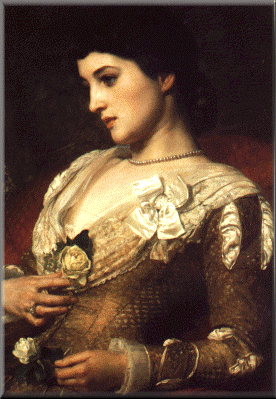 Born on the Isle of Jersey, she arrived in London in the mid-1870s with her alcoholic husband Edward Langtry and promptly entered society despite having little money. While her beauty at first created a mild interest, it was her attendance of social events clad in the same black dress that created a stir. When someone finally commented on her continuous use of that dress, she arrived at her next engagement wearing a white dress of similar fashion. This provocation created a furor and suddenly, artists wanted to paint her, hostesses vied to have her on their guest lists, and people (even the most fearsome dowagers!) even stood on benches in Hyde Park, or chairs at balls, to catch a glimpse of her. So great was her fame that her greatest wish–to be presented to Queen Victoria–was granted (some say at the instigation of the queen herself!). Coached by the highest in the land (the Prince of Wales, soon her lover), the wittiest (Oscar Wilde), and the most talented (James MacNeil Whistler), she cut a swath through aristocratic society. Frank Miles, one Lillie’s earliest acquaintances, capitalized on the increasing voraciousness of people for pictures of society beauties, and these women, subsequently dubbed “Professional Beauties” or, P.B.’s for short, took not only London at large by storm, but the known world.
Born on the Isle of Jersey, she arrived in London in the mid-1870s with her alcoholic husband Edward Langtry and promptly entered society despite having little money. While her beauty at first created a mild interest, it was her attendance of social events clad in the same black dress that created a stir. When someone finally commented on her continuous use of that dress, she arrived at her next engagement wearing a white dress of similar fashion. This provocation created a furor and suddenly, artists wanted to paint her, hostesses vied to have her on their guest lists, and people (even the most fearsome dowagers!) even stood on benches in Hyde Park, or chairs at balls, to catch a glimpse of her. So great was her fame that her greatest wish–to be presented to Queen Victoria–was granted (some say at the instigation of the queen herself!). Coached by the highest in the land (the Prince of Wales, soon her lover), the wittiest (Oscar Wilde), and the most talented (James MacNeil Whistler), she cut a swath through aristocratic society. Frank Miles, one Lillie’s earliest acquaintances, capitalized on the increasing voraciousness of people for pictures of society beauties, and these women, subsequently dubbed “Professional Beauties” or, P.B.’s for short, took not only London at large by storm, but the known world.
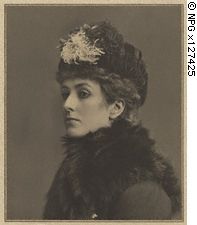 Just about any beautiful woman could become a professional beauty–not through success at court, but in the emerging celebrity culture associated with illustrated periodicals and mass-circulated photographs. The professional beauty needed not be rich, highly born, nor well educated–provided she had sense enough to escape from committing any glaring missteps–all that was required of her was that her face should be approved by society as a great beauty and her future was assured. Recognition as a P.B. was reward in itself. Reproductions of the beauties appeared in every store window and hung in every middle-class dwelling. The originals graced the mansions of wealthy patrons of the arts. Queen Victoria ‘s youngest son, Prince Leopold, became so enamored of a pen-and-ink sketch of Lillie Langtry he had seen while visiting Miles’s studio that he acquired it to hang in his bedchamber – until his mother snatched it down.
Just about any beautiful woman could become a professional beauty–not through success at court, but in the emerging celebrity culture associated with illustrated periodicals and mass-circulated photographs. The professional beauty needed not be rich, highly born, nor well educated–provided she had sense enough to escape from committing any glaring missteps–all that was required of her was that her face should be approved by society as a great beauty and her future was assured. Recognition as a P.B. was reward in itself. Reproductions of the beauties appeared in every store window and hung in every middle-class dwelling. The originals graced the mansions of wealthy patrons of the arts. Queen Victoria ‘s youngest son, Prince Leopold, became so enamored of a pen-and-ink sketch of Lillie Langtry he had seen while visiting Miles’s studio that he acquired it to hang in his bedchamber – until his mother snatched it down.
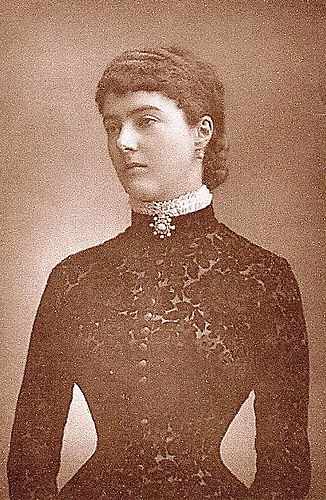 Women of superior social stations inundated the P.B. with cards for dinners and receptions; for a time no party was considered complete or successful without these ladies. People would receive invitations with “Do come, the P.B. s will be there,” and this meant the certain attendance of society. Artists vied with each other in inviting her to their studios in the hope that they would be permitted to paint or sketch her. The professional beauty need never purchase clothing or accessories again; all that was required of her was the murmur of her couturier’s or milliner’s names to guarantee instant success of that artist of fashion. “She was worth – literally – 100 paying customers. She was a walking – no a gliding – advertisement.”
Women of superior social stations inundated the P.B. with cards for dinners and receptions; for a time no party was considered complete or successful without these ladies. People would receive invitations with “Do come, the P.B. s will be there,” and this meant the certain attendance of society. Artists vied with each other in inviting her to their studios in the hope that they would be permitted to paint or sketch her. The professional beauty need never purchase clothing or accessories again; all that was required of her was the murmur of her couturier’s or milliner’s names to guarantee instant success of that artist of fashion. “She was worth – literally – 100 paying customers. She was a walking – no a gliding – advertisement.”
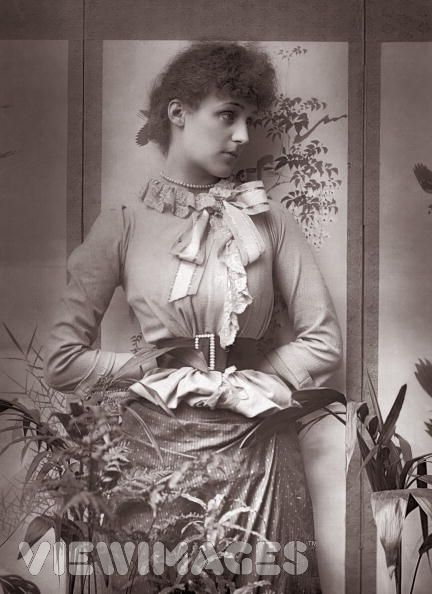 In London, the professional beauty was queen. Not a ball was considered a success without her presence. At dinner she eclipsed rank wealth and fame and was the object of attentions which would be flattering were they less curious and obtrusive. Should she ride in the Row a little cavalcade accompanied her, which only quit her presence when some very distinguished personage came up to canter by her side. At a country house party, no matter who may be the visiting, she was always the most favored of guests. So firmly did the professional beauty rule society that her word was law and her wishes commanded the amusement of the hour: If she voted guessing acrostics dull, acrostics were abandoned. If she was fond of hunting, the best and safest of mounts that the stables possessed were placed at her disposal, whilst the most sober and careful of grooms was to specially attend upon her and to see that her exquisite beauty should not for a moment be in danger.
In London, the professional beauty was queen. Not a ball was considered a success without her presence. At dinner she eclipsed rank wealth and fame and was the object of attentions which would be flattering were they less curious and obtrusive. Should she ride in the Row a little cavalcade accompanied her, which only quit her presence when some very distinguished personage came up to canter by her side. At a country house party, no matter who may be the visiting, she was always the most favored of guests. So firmly did the professional beauty rule society that her word was law and her wishes commanded the amusement of the hour: If she voted guessing acrostics dull, acrostics were abandoned. If she was fond of hunting, the best and safest of mounts that the stables possessed were placed at her disposal, whilst the most sober and careful of grooms was to specially attend upon her and to see that her exquisite beauty should not for a moment be in danger.
A fierce war of opinion as to their rival merits raged about them. Artists extolled Mrs. Langtry’s classical Greek profile golden hair and wonderful column-like throat, graced with the three plis de Venus, which made her an ideal subject for their brushes and chisels. Poems were written in celebration of the professional beauty, one of which was saved by Lady Randolph Churchill, herself a professional beauty:
First Lady Dudley did my sense enthral,
Whiter than chisel’d marble standing there,
The Juno of our earth “divinely tall,
And most divinely fair.”And next with all her wealth of hair unroll’d,
Was Lady Mandeville bright eyed and witty;
And Miss Yznaga whose dark cheek recall’d
Lord Byron’s Spanish ditty.The Lady Castlereagh held court near by,
A very Venus goddess fair of love,
And Lady Florence Chaplin nestled nigh,
Gentle as Venus doveAs gipsy dark with black eyes like sloes,
A foil for Violet Lindsay sweetly fair,
Stood Mrs Murietta a red rose,
Was blushing in her hair.And warmly beautiful like sun at noon,
Glowed with love’s flames our dear Princess Louise,
Attended by the beautiful Sassoon,
The charming Viennese!Then Lady Randolph Churchill, whose sweet tones
Make her the Saint Cecilia of the day;
And next those fay-like girls, the Livingstones,
Girofla Giroflé!And then my eyes were moved to gaze upon
The phantom like celestial form and face
Of the ethereal Lady Clarendon,
The loveliest of her raceThe beauteous sister of a Countess fair,
Is she the next that my whole soul absorbs,
A model she for Phidias, I declare,
The classic Lady Forbes
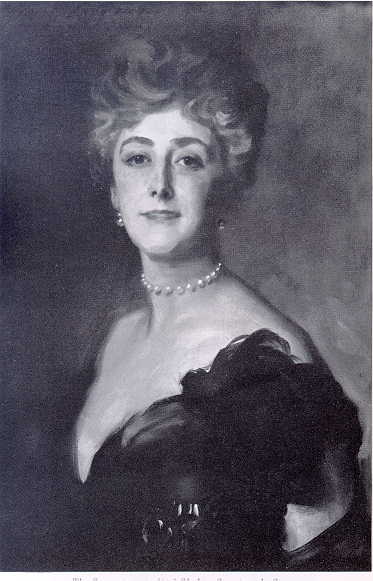 Other preeminent professional beauties were Lady Lonsdale (afterwards Lady de Grey), Lady Brooke (later Lady Warwick), the Duchess of Leinster and her sister Lady Helen Vincent, Lady Londonderry, Lady Dalhousie, Lady Ormonde, Lady Mary Mill, Lady Gerard, Mrs. Luke Wheeler, who always “appeared in black,” and Mrs. Cornwallis West, the mother of Lady Randolph Churchill’s much younger second husband.
Other preeminent professional beauties were Lady Lonsdale (afterwards Lady de Grey), Lady Brooke (later Lady Warwick), the Duchess of Leinster and her sister Lady Helen Vincent, Lady Londonderry, Lady Dalhousie, Lady Ormonde, Lady Mary Mill, Lady Gerard, Mrs. Luke Wheeler, who always “appeared in black,” and Mrs. Cornwallis West, the mother of Lady Randolph Churchill’s much younger second husband. 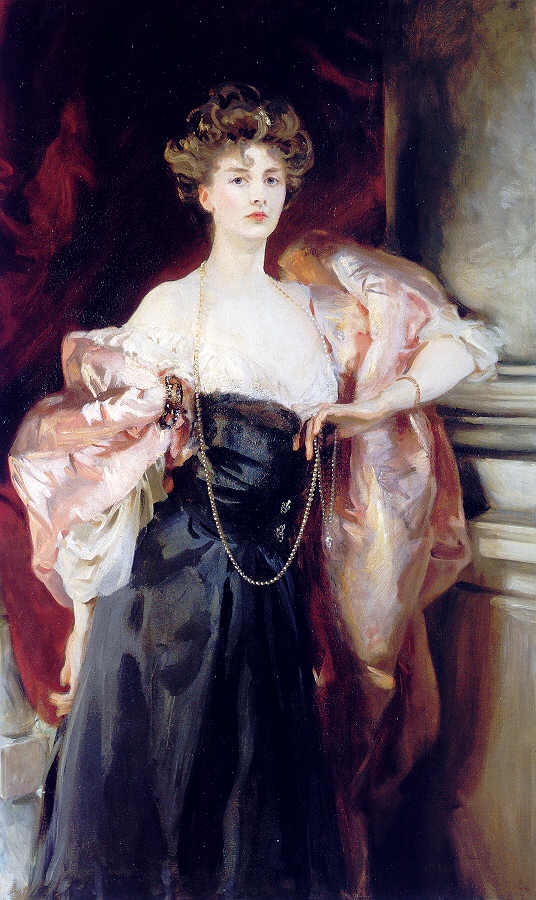 Accordingly, and some say, obviously, many of these women reigned briefly as the Prince of Wales’s mistress. In direct contrast to these London beauties, the professional beauties of Paris were not ranked or cataloged. They did not have their portraits published in the illustrated papers nor did they allow their photographs to be sold at the stationers. However there always existed a little staff of about twenty women who represented grace, beauty and Parisian elegance.
Accordingly, and some say, obviously, many of these women reigned briefly as the Prince of Wales’s mistress. In direct contrast to these London beauties, the professional beauties of Paris were not ranked or cataloged. They did not have their portraits published in the illustrated papers nor did they allow their photographs to be sold at the stationers. However there always existed a little staff of about twenty women who represented grace, beauty and Parisian elegance.
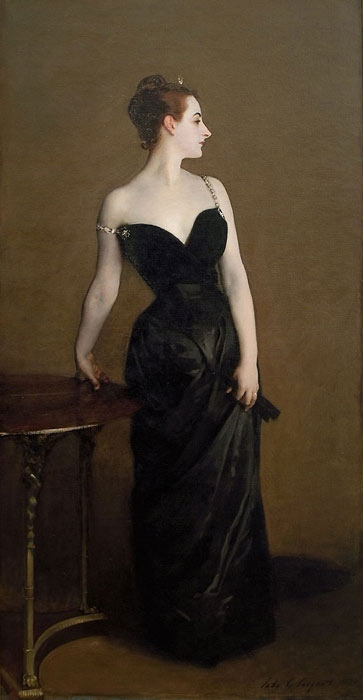 But one Parisian hostess did break the mold: Virginie Amélie Gautreau, who is better known to history as the subject of John Singer Sargent’s “Portrait of Madame X.” An American expatriate married to a wealthy French banker, when her painting was revealed in the Paris Salon of 1884, it caused a scandal. Already trailed by whispers of fast behavior, the portrait as painted, was of a sexually-aggressive woman clad in a figure-hugging black gown whose right strap had fallen–a hint that with “one more struggle“, wrote a critic in Le Figaro, “...the lady will be free“. Amidst the outrage and ruination of his career, Sargent painted over the strap to secure it on Madame Gautreau’s shoulder and concealed the painting for over thirty years. As for the lady, her reputation was destroyed and she passed the remaining years of her life alternately attempting to recapture her fame and escaping the realities of time by avoiding mirrors.
But one Parisian hostess did break the mold: Virginie Amélie Gautreau, who is better known to history as the subject of John Singer Sargent’s “Portrait of Madame X.” An American expatriate married to a wealthy French banker, when her painting was revealed in the Paris Salon of 1884, it caused a scandal. Already trailed by whispers of fast behavior, the portrait as painted, was of a sexually-aggressive woman clad in a figure-hugging black gown whose right strap had fallen–a hint that with “one more struggle“, wrote a critic in Le Figaro, “...the lady will be free“. Amidst the outrage and ruination of his career, Sargent painted over the strap to secure it on Madame Gautreau’s shoulder and concealed the painting for over thirty years. As for the lady, her reputation was destroyed and she passed the remaining years of her life alternately attempting to recapture her fame and escaping the realities of time by avoiding mirrors.
 The professional beauty’s American counterpart was found in the “Gibson Girl” of the 1890s and 1900s, as created by Charles Dana Gibson. The Gibson Girl set the first national standard for a feminine beauty ideal: “She was taller than the other women currently seen in the pages of magazines.. infinitely more spirited and independent, yet altogether feminine. She appeared in a stiff shirtwaist, her soft hair piled into a chignon, topped by a big plumed hat. Her flowing skirt was hiked up in back with just a hint of a bustle. She was poised and patrician. Though always well bred, there often lurked a flash of mischief in her eyes.”
The professional beauty’s American counterpart was found in the “Gibson Girl” of the 1890s and 1900s, as created by Charles Dana Gibson. The Gibson Girl set the first national standard for a feminine beauty ideal: “She was taller than the other women currently seen in the pages of magazines.. infinitely more spirited and independent, yet altogether feminine. She appeared in a stiff shirtwaist, her soft hair piled into a chignon, topped by a big plumed hat. Her flowing skirt was hiked up in back with just a hint of a bustle. She was poised and patrician. Though always well bred, there often lurked a flash of mischief in her eyes.”  The Gibson Girl appeared on saucers, ashtrays, tablecloths, pillow covers, chair covers, souvenir spoons, screens, fans, umbrella stands and was personified by Gibson’s wife, Irene Langhorne, Evelyn Nesbit and the Danish-American stage actress, Camille Clifford, whose towering coiffure and long, elegant gowns wrapped around her hourglass figure and tightly corseted wasp waist defined the style. Depicted as an equal and sometimes teasing companion to men, the Gibson Girl was provocative and independent, perfectly expressing the cool exuberance of the turn-of-the-century American lady.
The Gibson Girl appeared on saucers, ashtrays, tablecloths, pillow covers, chair covers, souvenir spoons, screens, fans, umbrella stands and was personified by Gibson’s wife, Irene Langhorne, Evelyn Nesbit and the Danish-American stage actress, Camille Clifford, whose towering coiffure and long, elegant gowns wrapped around her hourglass figure and tightly corseted wasp waist defined the style. Depicted as an equal and sometimes teasing companion to men, the Gibson Girl was provocative and independent, perfectly expressing the cool exuberance of the turn-of-the-century American lady.
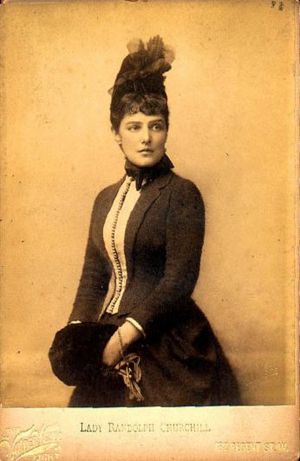 The life of a professional beauty could be wonderful, exhilarating and fun, but only on the condition that she remained beautiful and charming, had not a hairsbreadth of scandal attached to her name, and could financially maintain her socializing. This was near impossible not only because of her attachment to the spendthrift and frivolous Marlborough House Set, but also the passing of time. Lillie Langtry fell from grace when she bore a child out of wedlock, and only recaptured a bit of her fascination by becoming a moderately talented actress. Even aristocratic women found it difficult to escape the fate of chance: Lady Randolph Churchill was plagued with money troubles all of her life and Daisy Warwick, her family fortune run dry by the 1910s, attempted to blackmail George V into granting her renumeration for her amusement of his deceased father by threatening to publish the letters he exchanged with her during their relationship.
The life of a professional beauty could be wonderful, exhilarating and fun, but only on the condition that she remained beautiful and charming, had not a hairsbreadth of scandal attached to her name, and could financially maintain her socializing. This was near impossible not only because of her attachment to the spendthrift and frivolous Marlborough House Set, but also the passing of time. Lillie Langtry fell from grace when she bore a child out of wedlock, and only recaptured a bit of her fascination by becoming a moderately talented actress. Even aristocratic women found it difficult to escape the fate of chance: Lady Randolph Churchill was plagued with money troubles all of her life and Daisy Warwick, her family fortune run dry by the 1910s, attempted to blackmail George V into granting her renumeration for her amusement of his deceased father by threatening to publish the letters he exchanged with her during their relationship.
Truly only a step above a courtesan, the professional beauty was protected from scandal and the taint of sexual immorality by her rank and marriage. But in a time where women could be considered property (though this lessened considerably by the 1880s in comparison to earlier eras), and her social roles were defined and the boundaries between “public” and “private” were beginning to blur, the P.B. could essentially have the best of both worlds: the fame and fascination of an actress and the venerated social status of an aristocrat.
|
|
lice Keppel (born October 14, 1869, died November 22, 1947) was the most famous of the mistresses of King Edward VII. She was the great-grandmother of Camilla, Duchess of Cornwall,
Alice Keppel's grandfather, a Lieutenant-Colonel John Whittle Parsons, had been the Governor of the Ionian Islands at a time when then were British. He had married a local Greek girl there, and the couple later returned to his home in Scotland.
A daughter of this marriage, Mary Elizabeth Parsons, married one Sir William Edmonstone, 4th Baronet, who had entered the Royal Navy at a young age. Sir William was 31 when he married Mary Elizabeth.
Alice was the youngest of 9 children (8 girls and one boy) of Sir William Edmonstone and Mary Elizabeth Parsons. Alice (nee Parsons) Keppel was born October 14, 1869, in Scotland at Duntreath Castle, Loch Lomond. And grew up here at Duntreath Castle, the family home since the 15th century.
On June 1, 1891, she married the Hon. George Keppel, a son of William Coutts Keppel, 7th Earl of Albemarle. She was 22 when she married, he was 26. Within months of marrying, she is said to have taken a wealthy lover. Her first daughter was born in 1894, and the father was rumoured to be Ernest William Beckett, the future Lord Grimthorpe.
Early in 1898 she met Edward Albert, Prince of Wales (later King Edward VII), then aged 56. She was 29, and within a matter of weeks Alice was his official mistress. She appears to have been adept at keeping everyone happy, and she was very discreet. Through it all she managed to preserve her own reputation and her marriage to Colonel Hon. George Keppel. The Prince's wife, Alexandra of Denmark, the Princess of Wales, is said to have preferred her descretion, to the Prince's previous mistress, Daisy, Countess of Warwick. And the Duchess of Sutherland, Daisy's half-sister, remarked that the Prince, was "a much pleasanter child since he changed mistresses".
Alexandra was apparently grateful that she kept the Prince in a good temper. However she was (I guess, obviously) not altogether happy with the situation, and was particularly upset with annual Alice's annual appearance at the Cowes regatta. It is always mentioned that Alice had a command of bridge was particularly appealing to Prince Edward.
The Keppel family moved house, from Wilton Crescent to 30 Portman Square where their second daughter, Sonia (Camilla's grandmother), was born in 1900.
It is difficult to judge whether George Keppel tolerated or condoned her being a royal mistress, but according to one of their daughters theirs was a marriage of "companionship of love and laughter"
Apparently when in Baden, a Grand Duke is said to have asked George " Are you related to the king's mistress?", an insult which he is said to have ignored. He went into business in the employ of Sir Thomas Lipton.
In 1910, when Edward VII was on his death bed, and he asked for Alice's presence. Queen Alexandra reluctantly allowed her to be present whilst he was still conscious. However, when the king lost consciousness, she hissed to the doctor, "Get that woman away."
After the king's death, the Keppels sold up in England and spent two years travelling in the Far East. On their return they bought a new house at 16 Grosvenor Street. During the First World War (1914-1918) she helped a friend, Lady Sarah Wilson, run a hospital in Boulogne.
Towards the end of the war her daughter, Violet, became involved in a love affair with Vita Sackville-West, something just not done in those days. To avoid inevitable scandal Violet was "married off" to Denys Trefusis. In a series of moves, Violet threatened to divorce Denys, Alice cut off her daughter's allowance and this eventually brought an end to Violet's and Vita's affair.
In 1927 the Keppels sold their Grosvenor Street house and moved out of England. They bought the Villa dell'Ombrellino, near Florence, Italy where they lived, with the exception of returning to the UK during the Second World War, for the rest of their lives. Alice Keppel voiced her opinion that "things were done much better in my day" when the abdication of Edward VIII was announced over his intention to marry Wallis Simpson,
In 1940 the Keppels returned to England and went to live with their daughter Sonia in the country. However she decided that she preferred "bombs to boredom" and they moved into rooms in the Ritz Hotel in London for the rest of the war. It was during this time that somewhat surprisingly Alice together with her daughter Violet, paid a visit to Queen Mary.
In 1946 they were able to return to their house in Italy, but Alice was by now terminally ill. She died aged seventy-eight in November 1947. Her husband George died two months later.
So Camilla would never have known her great grandmother, being born 17th July 1947. Alice Keppel 's daughter Sonia Keppel (Camilla's grandmother) was born after her mother became involved with Edward, but most historians believe she really was fathered by Alice Keppel's husband. (Sonia was said to have a strong resemblance to George Keppel (though that probably does not mean anything), and the king never treated her like his daughter, and it was Violet that her mother took to visit Queen Mary during the war.) But if Sonia was the king's daughter, that would make Camilla and Charles the somewhat remote relations of second cousins once removed.
|
|
Ricordate Anatolio Sgozzaloca,lettori miei? Lo avevamo lasciato in pieno idillio con la contessa Marianastasia Strascicotti,nostra vecchia conoscenza.
Beh,vi dico che davvero ci vuole un fisico bestiale per sopportare tutto quello che l'Anatolio ha sopportato a causa sua e uscirne vivi!
Tutto è cominciato una mattina a colazione,quando la Strascicotti ,dopo averlo squadrato con disgusto,ha emesso il verdetto:Anatolio doveva ASSOLUTISSIMAMENTE dimagrire!
Il poveraccio ha provato a farle capire che lui nei suoi 160 kg si sente un dio,ma non c'è stato verso:da quel preciso momento per lui è iniziato l'inferno!
LUNEDI'- La Strascicotti ha allucchettato il frigo e fatto sparire la provvista di dolciumi che Anatolio nasconde nello studio.Il prando del pvoer'uomo è stato mezzo uovo sodo e una foglia d'insalata
MARTEDI'- Rivoltasi a un dietologo fiorentino,la Strascicotti è tornata a casa con un beverone nauseabondo,che Anatolio ha dovuto bere tutto.
in teoria l'intruglio eliminava il senso di fame.
In pratica,Anatolio fa fuoco dalla bocca e fumo da un posto innominabile e ha una fame boia
MERCOLEDI'- La Strascicotti ha iniziato lo Sgozzaloca all'aerobica.
Anatolio ha una fame da Guinness
GIOVEDI'-La Strascicotti ha portato Anatolio a far jogging nei boschi.Rincrentinito dalla fame,lo Sgozzaloca è finito in una macchia di rovi e pare un porcospino obeso
VENERDI'- Anatolio ha morso una natica della colf Fatima Makimammazzameh,scambiandola per un panino al salame.Fatima,pensando volesse violentarla,ha dato di piglio alla scimitarra del suo antenato Mohammazzapurateh e per poco non lo ha spedito al Creatore.
SABATO-Oggi Anatolio,col tovagliolo al collo,armato di coltello e forchettone,con una luce folle negli occhi,ha inseguito il cane,col chiaro intento di mangiarselo vivo.
Si è poi dato alla fuga,azzannando chiunque incontrava.
Ireneo lo ha tramortito con lo spegnimoccoli e poi ha intimato alla Strascicotti di non lasciare uscire Anatolio senza guinzaglio,museruola e medaglietta.
DOMENICA-Stufo di subire,Anatolio ha chiuso la Strascicotti in cantina poi ha scassinato frigo e dispensa.Sono 16 ore che mangia senza interruzione
Sono passati due giorni.
Lo Sgozzaloca ha preso una terribile indigestione,ma è felicissimo.
La Strascicotti lo ha lasciato e si è portata via colf e cane (ha dovuto farlo:Fatima se sente la voce dell'Aantolio attacca a urlare e il cane a ululare,e i paesani non li reggono più)
Per adesso a S.Tobia è tornata la calma e io vado a mangiare
|
|
Jacobite was the name given to supporters of King James VII of Scotland and II of Britain who fled from the country in 1689 to escape an invading army led by William of Orange (also known as King Billy). There was fear throughout Britain that James would re-instate Catholicism as the national religion so the parliaments invited his daughter Mary and her Protestant husband William to take over the throne. The decisive battle of the Boyne in Ireland saw James completely defeated and he left the British Isles. His son was born in 1688, James Francis Edward Stuart (the Old Pretender) was to have been James III of Britain. However the flight of his father meant that he grew up in exile. He took part in the aborted invasion of 1708 with French assistance and went on to lead the 1715 uprising which also ended in failure. Although brave and honourable James was largely ineffectual and continually suffered from bad luck earning him the nickname 'Old Mr. Misfortune'. The Old Pretender had two children, Charles and Henry. Charles went on to become known as Bonnie Prince Charlie, while Henry became a Cardinal in the Catholic Church. Both were raised in Rome and protected and supported by the pope, particularly in their later years. |
| The Stuart's Catholicism prevented many would-be supporters who were Protestant from joining the cause. Although some Protestants did become Jacobites the fear in Britain that the Stuarts would re-introduce Catholicism as the official faith dealt a blow to their restoration efforts. The Jacobite court settled in Rome in 1719 and was protected and partially funded by the pope from then until the death of Henry in 1807. Many countries wanted to support the Jacobite cause and return the Stuarts to the throne so they would be treated favourably by Britain, or because they disliked William of Orange. The Stuarts always looked to France first for aid as it was the strongest Catholic power, it had a long rivalry with England and it was close. Louis XIV of France supported James VII until 1713 when he repudiated the Jacobites and expelled the Old Pretender. Once again in the 1740's the French prepared to invade but were prevented by poor weather and the 1745 rising failed. Charles fled to France after the defeat but was expelled so the French could make peace with Britain. King Charles XII of Sweden also proposed to help the Jacobite campaign by providing 10,000 troops, however negotiations broke down in 1718 because the |
Swedish king died. Sweden remained on good terms with the Jacobites and even sent a secret regiment for unacknowledged service in Scotland in 1745. Other offers of help from Spain and Russia broke down due to problems in negotiations and the weather prevented the Spanish armada from assisting the 1719 rising. Many of these negotiations for foreign support were not helped by the manners of Bonnie Prince Charlie. He was a heavy drinker and became angry when things did not go his way. The Prussians withdrew support after Charles had become extremely drunk and insulted them publicly. Jacobites had their own material culture and an underground society. They wore secret symbols to illustrate their allegiance to the Stuarts and often met in Jacobite taverns to sing seditious songs or to drink to the king over the water. Many songs were popular amongst the Jacobites and some have survived through to the modern day, 'The Bonnie Banks of Loch Lomond' for example. People would wear a white rose to celebrate the Old Pretender's birthday or a white cockade on their hat to show their support of Jacobitism. Jacobites are also often associated with tartan; of course the Highlanders who fought for the Stuarts were mostly clad in their clan tartans. |
Also in the 1740's another way of displaying Jacobite sympathies was to wear a tartan waistcoat. A prominent English Jacobite had an entire tartan suit made and it can now be seen on display at the National Museum of Scotland, in Edinburgh. The traditional kilt was banned for a time after the defeat of the Jacobites because of its rebel associations. There were several military campaigns in Britain in support of the Jacobites but all of them were flawed either in planning or execution and sometimes in both. Risings took place in 1715, 1719 and most famously in 1745, not to mention the aborted rising planned in 1708. The earlier risings included Highland and Lowland Scots, English and French but in 1745 the Jacobite force was almost exclusively made up of Highlanders. Prince Charles landed on the small island of Eriskay and gathered the loyal clan Chiefs before advancing on Edinburgh. The Jacobite army took Edinburgh without much resistance and defeated a government army at Prestonpans by cleverly sneaking across a marsh in the mist |
|
and surprise attacking them. The Highlanders only wanted to take Scotland, but Prince Charles was greedy for the English throne and convinced the army to push on southwards. He lied and told them that English Jacobites would meet up with the Highlanders further south, in fact the English Jacobites had decided not to join the uprising. They advanced to Carlisle then Manchester, and eventually as far south as Derby. It was here with three armies lining up to fight them that they discovered Charles had been lying and made the long retreat home. A sulky Bonnie Prince Charlie accompanied them home, drinking and moaning all the way. |
| Eventually the weary Highlanders were cornered at Culloden and slaughtered as Charles made his escape. The Jacobite struggle has been romanticised ever since and helped create the image of the Highlander as the loyal and brave soldier. Much of the romanticisation of the Jacobite uprisings especially in 1745 is unjustified. There are several misconceptions surrounding this area of history. Firstly the Jacobite cause was not about Scotland versus England there were people of each nationality on either side. Secondly Bonnie Prince Charlie, although highly charismatic, was no hero, he could be viewed as a spoilt alcoholic aristocrat who had no problem leading loyal men to their graves for his own personal ambitions. Thirdly Jacobitism did not really stand for a noble cause, it sought to put the Stuarts back on the throne and they stood for the 'divine right of kings' which meant they believed the king was chosen by god and should have absolute authority. |
The Stuarts also advocated the Catholic religion (which many Scots were against). Ultimately it seems strange that the Jacobites have been immortalised on shortbread tins as a symbol of Scotland. Whatever the reason, the Jacobite cause has been remembered by Scots, and appropriated as a nationalist symbol. The memorial at Culloden on the anniversary of the battle still attracts huge crowds today. | |
| Acknowledgements: Prince Charles Edward Stua | |
|
|
|  |
 |  |  |
 |
|
|
Veleggio come un'ombra
nel sonno del giorno
e senza sapere
mi riconosco come tanti
schierata su un altare
per essere mangiata da chissà chi.
Io penso che l'inferno
sia illuminato di queste stesse
strane lampadine.
Vogliono cibarsi della mia pena
perché la loro forse
non s'addormenta mai.
|
|
Vanessa Bell è la sorella meno nota di Virginia Wollf.
Questo bellissimo libro racconta il loro rapporto quais simbiotico,spessissimo conflittuale,vivacissimo.Veramente da leggere!
|
|
|
|









Inviato da: RicamiAmo
il 01/08/2014 alle 18:11
Inviato da: Dolce.pa44
il 26/07/2014 alle 18:22
Inviato da: do_re_mi0
il 23/04/2014 alle 18:01
Inviato da: odio_via_col_vento
il 14/04/2014 alle 20:57
Inviato da: Krielle
il 23/03/2014 alle 04:38